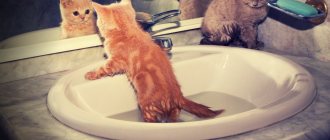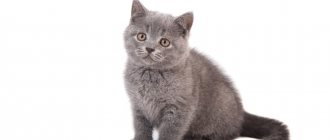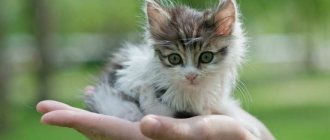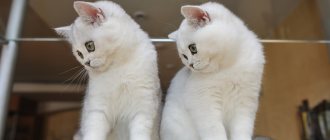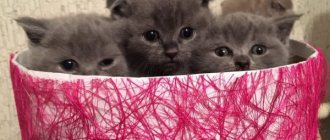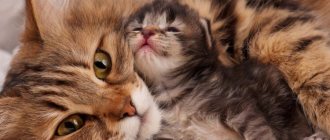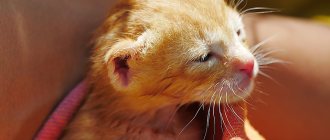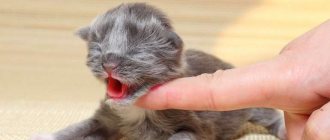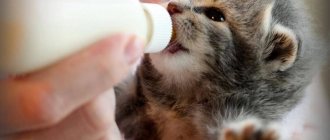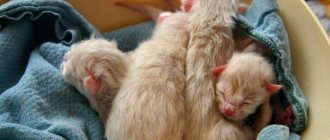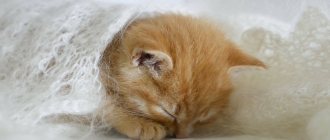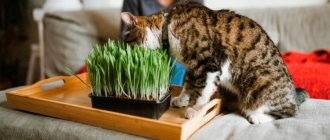The birth of kittens in a family is an amazing event. If your cat gives you offspring for the first time, then you are probably now trying to find answers to a lot of questions: how and whom to feed, how to help the mother cat, will she cope with raising children, will the newly born babies be able to become full-fledged cats and cats, how to check if they are healthy whether they and a host of others. This article will help you understand all the nuances of feeding and caring for cat babies and raising happy and healthy pets.
Newborn kittens
Giving birth to a cat: what to expect and how to prepare?
You can understand that your pet is preparing for childbirth by her behavior:
- the cat will become restless;
- the cat will often meow and caress;
- the cat will look for a suitable place to give birth.
In order for the birth to be comfortable, the cat looks for a suitable place in advance.
The pet will strive to find something warm and closed from prying eyes, which can be:
- cozy closet;
- dresser;
- a stack of clean bed linen.
In a word, anything – as long as it’s soft and warm. If you are not happy with the prospect of giving birth on clean and bright things, take care of creating a birth nest a couple of weeks before the birth - after all, the expectant mother will still need to get used to the new sleeping place.
Before giving birth, the cat will give signals with all its appearance
It is important that it be comfortable and free - after all, the cat will not only have to give birth in it, but also spend the next couple of months with her offspring - this is how long it would be desirable for the kittens to spend with their mother, because she will teach them everything that will be useful in their lives - starting from feeding and personal care, ending with the fact that if you jump on a chair after a person has gotten up from it, it will remain warm.
You can either buy a house for a cat or build it yourself - from boxes (just not from those where any chemicals are stored), plywood or wood and clean paper, newspapers, cotton fabric as filling. In addition to convenience, a maternity house must meet the following requirements:
- safety;
- purity;
- comfort.
If desired, a special maternity hospital for cats can be purchased
Safety
Both for the cat and for the kittens themselves. Firstly, the sides must be high enough (about 30 cm) so that the kittens cannot get out of there without permission, but at the same time the cat must freely leave and enter the house, without fear of crushing the kittens when jumping into the nest. It is equally important that other animals do not have access to the den - after all, they can harm the babies and bring infections that are extremely dangerous for the fragile cat’s immunity.
It is necessary to provide the cat with a comfortable and quiet place.
In addition, children should not be allowed to carry kittens in the first week of birth, and in general it is not recommended to touch babies unnecessarily - this makes the mother nervous and can provoke her to aggression towards her own children, interfere with the successful socialization of kittens among their brothers and increase the risk of infection babies with various viruses and infections.
Purity
Before giving birth, the house should be treated with a disinfectant that has absolutely no odor and covered with clean materials:
- paper;
- breathable fabric;
- newspapers, etc.
Important! The family's den should be located away from any strong odors and sounds - chemicals, garbage, detergents, noise and any irritating factors.
It is best to place a disposable diaper on the bottom of the bed
The bottom of the nest can be covered with a disposable diaper - it is convenient to change it daily. It is necessary to regularly clean the den because if there is blood and signs of childbirth, the cat will drag the kittens - after all, other predators can find them in nature by their smell.
Comfort
Considering that childbirth is a difficult matter, the mother in labor needs to be provided with the most comfortable conditions in the nest. It must meet the following requirements:
- be stable, otherwise the erratic movements of the kittens can knock over this nest;
- stay warm (but temperatures above 28ºC are harmful for both mother and babies, as they can cause overheating);
- do not come into contact with drafts.
The cat will be nervous if she has to lose sight of the kittens in order to go about her business, so it is better to move the feeder, water bowl and tray closer to the nest in advance. However, there is no need to put food and water in the house itself - it will be much easier for you to clean it when the cat leaves it.
The expectant mother must be provided with everything necessary
Development at 5-6 weeks
During this period, it is recommended to carry out the following activities:
- show it to a veterinarian for the first time, who will record the level of development and prevent developmental delays;
- The baby should be actively transferred to artificial nutrition and given no more than 100 grams of wet food daily;
- organize your own place for each of the kids;
- show kittens to direct buyers or purchase a baby by booking it in advance at the nursery.
During this period, it is recommended to organize six meals a day, which will include no more than 100 grams of food per meal. Such nutrition will allow the baby to correctly go through all stages of kitten development and become sufficiently strong. It is recommended to be attentive to the prevention of various parasites and carry out timely vaccination and deworming.
On the eve of childbirth
Usually a woman in labor copes with childbirth on her own, but a responsible owner should keep ready everything that may be useful during childbirth: clean towels, disposable diapers and gauze napkins, scissors and thick threads in case you have to cut the umbilical cord yourself, boiled water and a first aid kit, the contents of which should be discussed with your veterinarian in advance.
If your pet is constantly being observed by the same doctor, ask him for a phone number before giving birth in case of unforeseen circumstances or find contacts of a veterinary hospital where 24-hour consultation is available. Also make sure that you can go to the nearest veterinary clinic at any time, which is always open and you know the way to it and its exact address, in case you have to get there by taxi or on your own.
Childbirth is a moment of crisis for any cat and requires control from the owner
If a cat gives birth safely at home, she will eat the afterbirth after the kittens - this is absolutely normal. Some experts believe that it is enough to give the cat the afterbirth of only one kitten - especially if she has problems with the gastrointestinal tract. By the way, if the labor is long, then it is allowed to feed and water the woman in labor - this will give her strength. After giving birth, you need to clean the nest and leave the cat alone - she will have to carefully lick and feed each kitten.
By the way! More complete information on how to deliver a cat can be found in a separate article on our portal.
Development from the fourth to the sixth month
During this period, it is recommended that he trim his claws for the first time; it is necessary to monitor the following indicators:
- height, which will depend on breed and gender;
- weight, which must be at least 1.4 kg;
- constant activity and good socialization.
Until six months, it is not recommended to give the baby food that is intended for adult cats, as it will not provide the necessary development and the intake of all necessary microelements.
Up to six months, it is recommended to adhere to five meals a day, which ensures good functioning of the gastrointestinal tract and stable development of your kitten. At the end of 6 months, the baby's teeth will begin to change. This age is most optimal for castration. It is advisable to carry out a third deworming in order to eliminate the presence of parasites in your pet’s body. In the sixth month, it is recommended to switch the baby to three meals a day, which corresponds to his level of development.
Caring for kittens
After a successful birth, a healthy mother is able to independently care for her babies: she gives them warmth, food, love and care. All the owner needs to do is to provide the nursing mother with adequate care and enhanced nutrition; many brands of cat food produce lines specializing in feeding pregnant and lactating cats.
After giving birth, a healthy cat can take care of her kittens on her own.
The main concern of a cat who has given birth is to feed each baby to its fullest, warm it up and lick it. When using the toilet, mother pays special attention to the tummy and anus area - this is necessary so that the babies can pee and poop, because they cannot yet do this on their own. The following table contains information regarding what you can and cannot do with newborn kittens.
Table 1. Rules for caring for newborn kittens
| Allowed | Forbidden |
| Take care of the cat and its offspring | Handle kittens unnecessarily |
| Feed a nursing cat heavily | Keep the family near strong lights, loud sounds and unpleasant odors |
| Keep mother and babies in a warm and safe space | Allowing children to pull kittens out of the nest, to irritate the cat, to make noise around a cat with kittens |
| Do not disturb either mother or babies, protect them from harsh light, sounds and smells | Feeding kittens cow's milk can cause diarrhea and various intestinal diseases, including incurable diseases. |
| Weigh all kittens at birth and every day for the first two weeks and record each kitten's weight in a chart. | Allow other animals to enter the nest and have contact with the kittens until they are one month old |
A month later
Caring for a one-month-old kitten without a cat is also based on a specific diet and careful care. It is at this time that the cat instills cleanliness in the kittens, teaches them to wash themselves and go to the litter box.
Nutrition
Starting from the fourth week, kittens should gradually be accustomed to adult food. But it’s too early to give them dry food. Some manufacturers offer various mousses and pates as complementary foods. For example, in the Royal Canin line this is Babycat Instinctive mousse for kittens. It is suitable for babies aged four weeks to four months.
Subscribe to the newsletter and receive a discount from the Pet store
Thanks for subscribing!
An email with a promotional code has already been sent to your email.
Care
At one month, kittens begin to show character, become interested in the world around them and explore everything new. Be sure to start taming them so that they are not afraid of humans. Take them in your arms, gradually increasing the caress time from two to three minutes to 40 minutes a day.
At the age of four weeks, kittens can already wash themselves and also learn to go to the litter box. The owner will have to teach them to the second point. Don’t forget about the rules of hygiene: caring for eyes and claws, as well as combing - animals should know these procedures from childhood.
Caring for kittens without a cat is painstaking, but extremely rewarding work. A little attention, care and affection, and the kittens will grow up healthy and beautiful!
Supplementary feeding
Newborn kittens eat every 1.5-2 hours. If the babies have a mother and she eats fully, which means she receives all the minerals and trace elements necessary for her situation, then her kittens will be well-fed and healthy. There are circumstances in which kittens will have to be supplemented with breast milk or completely switched to artificial feeding, for example, if:
- the mother of the kittens did not survive or refused to feed the cubs;
- the cat has infectious diseases or feeding kittens can deplete her body;
- the cat has little milk - in this case, its nutrition should be increased;
- there are too many kittens in the litter;
- If the baby is too weak, the brothers take away the nipple or he cannot find it or suck on it.
Newborn fold kittens
How to set up a place for kids
To keep newborn kittens, it is necessary to create a “nest box”, which can be made from an ordinary box or a container for transporting cats with rigid walls.
This box should be lined with warm and soft material, but not too fleecy, so that the crumbs do not “get stuck” in it. The optimal temperature for kittens in the first week of life should be about 30 degrees. In the future, it can be lowered to 24 degrees. You can use a heating pad or space heater to keep the box warm. But kittens should still be able to crawl away from the heat source if they suddenly feel hot. Therefore, you will need a fairly spacious box.
Foster mother for kittens
If for some reason you have to replace a mother cat, then the main thing you need to know is that feeding and raising kittens is hard work. At the same time, it must be taken into account that no matter how much a person cares for a newborn kitten and no matter how much he loves it, the chances of the baby being born are in any case lower than if the kittens had a mother. Therefore, if it happens that the biological mother cannot take care of the babies, find them an adoptive mother. Any nursing cat, with the right approach, can accept someone else’s offspring, the main thing is to approach the matter wisely.
If the biological mother cannot take care of the babies, find them a foster home
In order to “transfer” kittens to another nursing cat who is not their mother, you need to follow a few simple steps:
- place the kittens in the room where the potential mother is - usually hungry kittens squeak pitifully and she can find them herself;
- give the babies a cat smell - you can place them in the nest while the cat is away or lead each kitten around its mother while she sleeps;
- allowing the mother to sniff the kittens - this will be the main greeting ritual;
- make sure that the mother licks each one - this will mean that she has accepted the baby into the family and he is a full-fledged member of it.
Licking is a sign that the kitten has been accepted by the cat.
There are known cases when representatives of completely different species and subspecies became mothers for cats and female cats - for example, in one of the zoos in Thailand, a tigress became a mother for piglets. True, it turned out that she herself was raised as a pig until she was 4 months old. If you didn’t manage to find a parent for the babies, then you will have to not only learn how to feed them properly, but also become a full-fledged mother, and this means efficiently performing 4 most important functions for newborn kittens:
- feed;
- warm;
- ensure hygiene and monitor health;
- teach.
Essentials
Before you bring a newborn or older kitten home, you should purchase a tray with filler, food bowls, a scratching post, toys, grooming tools, bedding, and a carrier. Most of these items will also be needed to care for an adult cat, so you should choose them responsibly.
global $ads_google; //data-ad-slot=”2475549904″ $ads_google = empty($ads_google) ? false : true; ?> if ($ads_google == false) {?>
$ads_google = true; ?> } ?>
Tray
Even if the cat is expected to be outdoors in the future, a small kitten will need an indoor litter box. If the grown pet does not leave the house, the tray will remain a permanent place for him to cope with his daily needs. Therefore, the toilet container should initially be convenient for use and cleaning. All modern models of trays are divided into two types: closed and open. The design of the latter assumes the presence or absence of filler.
Open trays with grids are not filled with absorbent material. They allow you to save on filler. But such toilets require timely cleaning, otherwise the air in the house accumulates a specific odor. If the container is filled with filler, the problem partially disappears, since most materials have adsorption properties.
Closed trays look like a house. They use special fillers that absorb the smell of urine and do not leave marks on the paws. An enclosed litter box is convenient in the home as it looks aesthetically pleasing and does not create problems caused by the unpleasant odor from cat feces. A characteristic feature of a closed tray is its large size, so it can be difficult to find a place for it in the apartment. Another disadvantage of such products is the high price.
The baby must be toilet trained from the first days of life in the house; postponing this moment of education until “later” can create unwanted problems.
Tray filler
Cat litter for the litter tray differs in composition. This determines their appearance and principle of operation. According to the last criterion, toilet material is divided into two types: clumping and absorbent. When wet, particles of clumping filler stick together into lumps. After they are removed, a new portion is added to the container. This filler is completely replaced every 5-7 days. The composition of clumping varieties can be different, most often these are clay minerals:
- vermiculite;
- atapulgitis;
- bentonite.
It is recommended to use clumping clay litter only when the kitten grows up. This is explained by the fact that babies often taste everything, and mineral lumps that get into the stomach can cause health problems. In addition, wet particles stick to the paws. For small cats, a litter made from ground corn cobs, paper, and wood is desirable. If such lumps enter the intestines, they come out naturally without causing harm to health.
The absorbent filler, unlike ordinary sand, consists of large or small granules with high adsorption capacity. Once wet, the liquid is quickly absorbed by the material, leaving the bottom of the tray dry. The composition of the material can be very different:
- clay minerals;
- blotters (clay with paper);
- wood pellets;
- wood shavings;
- silica gel;
- corn granules.
When caring for a kitten, this material is changed every time the pet goes to the toilet. The choice of filler is determined not only by the characteristics of the constituent components, but also by the preference of the kitten itself. If for some reason the material causes aversion in a young cat, then it is worth trying a different variety.
Choosing a place for the toilet
global $ads_google; //data-ad-slot=”2475549904″ $ads_google = empty($ads_google) ? false : true; ?> if ($ads_google == false) {?>
$ads_google = true; ?> } ?>
Most often the tray is placed in the bathroom or toilet. In this case, the problem with the smell and not very aesthetic appearance of the accessory after the cat has visited it is solved. But in this case, care must be taken to ensure that access to the bathroom is always open to the small pet. In some cases, the container is placed in the hallway. This is convenient for a cat, but not always comfortable for a person. The compromise in this situation is a closed tray.
scratching post
A cat's growing claws need constant sharpening. If the scratching post is not prepared, then damage to the upholstered furniture in the house is guaranteed. Various types of devices help satisfy a cat’s reflex in sharpening its claws. This can be a board attached to the wall, covered with a soft thick fabric, or a vertical post with sisal thread wound around it. The working area of the scratching post should be at a height accessible to the baby.
To accustom a kitten, it is recommended that you first bring it to this accessory and place its paws on a rough surface. You can additionally spray your homemade sharpener with catnip. The pleasant smell will attract the kitten to the device and gradually it will get used to sharpening its claws in this particular place.
Dishes
The rules for caring for a kitten dictate the need to select three bowls for food. The first is for water, the second is for dry food, the third is for wet or liquid food. The quality of the material from which the dishes are made remains at the discretion of the owner. It can be plastic, metal, ceramics, glass. The main thing is that the bowls are durable, without chips or cracks.
Another necessary condition is the stability of the containers. A bowl that slides on the floor will make your cat uncomfortable while eating. To avoid discomfort, it is advisable to choose plates with a stable platform, the surface or rim of which has an anti-slip coating.
When buying plastic dishes, you need to make sure that they do not emit harmful substances (phthalates), which can cause acne in cats.
Toys
Fluffy babies love to play, so you need to prepare a variety of toys and activities for them. Both ready-made and home-made products are suitable for the game. Pet stores offer a wide selection of jumping, rolling, and moving toys. It is important that they meet several requirements.
Firstly, the toy should not be too small, otherwise an inexperienced baby may swallow it. Secondly, only light objects that a weak kitten can move are suitable for play. Thirdly, the product should not be too hard so that a growing cat does not break its teeth when biting it.
If your kitten has to play alone, buy sound toys for him - they will create a feeling of feedback.
Hygiene and grooming items
global $ads_google; //data-ad-slot=”2475549904″ $ads_google = empty($ads_google) ? false : true; ?> if ($ads_google == false) {?>
$ads_google = true; ?> } ?>
Hygiene procedures are mandatory for cats of any age. Caring for a kitten includes brushing the fur, cleaning the ears and eyes, and bathing. The teeth and claws of the animal are not ignored. For all care activities, it is necessary to prepare a set of tools and products.
To keep your cat's fur in perfect condition, you will need combs in the form of a brush, comb, or mittens. For a long-haired pet, the kit is completed with a slicker brush and a tangle cutter. Kittens of short-haired breeds are combed once a week, long-haired ones - up to three times. During molting, this procedure is repeated daily.
For detergents, buy hypoallergenic shampoo (preferably with a conditioner effect). When the baby reaches the age at which bathing is allowed, these hygiene items should already be at the ready. You can also keep the coat in a clean, beautiful condition using grooming sprays. They clean hair from dirt, make combing easier and allow you to do without water procedures.
To care for a kitten you will need cotton pads and swabs, hydrogen peroxide. Using these accessories, the cub's ears are cleaned once a month.
Nutritional Features
Feeding is the most important process in the first weeks of a baby's life. When the kittens are near the cat, they can at any time cling to the food source, but in its absence, you will have to provide the kitten with regular food - every 1-2 hours. In the first week of life, kittens eat little - a couple of spoons of milk, but often, so such a time interval is necessary.
Feeding a kitten with a syringe
It is important to know! Cow's milk is strictly prohibited for kittens in the first months of life - it can cause diarrhea, which prevents the entry of useful and nutrients into the body, which can lead to the death of the babies.
Milk substitutes
It is recommended to feed newborn kittens with a cat's milk replacer. It is designed specifically for kittens, so its composition is balanced specifically for the growing cat’s body. It is believed that cat's milk is much more nutritious than cow's milk, therefore all the microelements and vitamins that kittens need at this age stage are added to the milk substitute purchased at a specialized pet store or veterinary pharmacy.
A special syringe for feeding kittens is often included with the milk replacer.
The packaging with the substitute always contains cooking instructions and a table indicating the ratio of the age or weight of the kittens and the dosage for one meal. All you need for feeding is a bottle and a nipple, which, as a rule, are included in the package with a milk replacer. If you don’t have these tools, you can always buy them in the same place as baby food or replace them with a pipette and a syringe without a needle. Sometimes the instructions for the substitute indicate that it is necessary to prepare it with bottled low-mineralized water, but if necessary, it can be replaced with filtered or settled boiled water.
You can read more about syringe feeding kittens below.
Feeding kittens with a syringe
It is important to know! The food temperature for newborn kittens should be between 36-38°C.
How to feed kittens correctly?
Kittens, like human babies, need to be fed in an upright position to avoid injury. You need to press lightly on the bottle, but under no circumstances pour the milk mixture into the kitten - he must suck the “milk” himself. You can tell if the baby is full by his behavior: a hungry cat will squeak and crawl in search of his mother, and a well-fed cat will peacefully fall asleep.
It is important to know! If it is not possible to feed kittens with a special milk substitute for kittens, you can dilute it with formula for children under two weeks of age, but provided that the consistency is 2 times thinner than indicated in the instructions for the infant formula.
An example of a milk replacer for kittens
Even if kittens live with a nursing mother, at the age of 3-4 weeks they should be introduced to complementary foods:
- low-fat cottage cheese;
- milk porridge;
- scraped meat;
- special delicate pates and mousses for kittens;
- dry food granules for kittens soaked in milk.
The amount of complementary foods should start with no more than 5-15 g and gradually increase. Complementary foods should be given before the main meal.
Video - Feeding newborn kittens
Your kitten: 4 weeks
- Physical development : At 4 weeks of age, kittens' vision and hearing will improve significantly. The kitten's teeth will continue to develop. The long teeth next to the incisors, called canines, will begin to extend through the gums. The claws will be retractable.
- Behavioral Development : Four-week-old kittens will confidently learn and develop coordination that allows them to walk, run, and even begin to play. With enhanced senses, they will be noticeably more responsive, making frequent eye contact with caregivers and reacting to sights and sounds in the environment. Their caregiving skills may be limited, but they are improving. They will use a litter box.
- Average temperature : 37-38 ℃. Continue to provide a source of heat for 4-week-old kittens, although they will likely only use it when resting. The kitten's environment should be comfortably warm and should never be below 21-23 degrees Celsius.
- Average weight : 450-550 grams
- Care information : Four-week-old kittens belong to their mother. Orphans this age should be bottle-fed every five hours, including at night. Four-week-old kittens will usually use a litter box and can be trained to use toys.
Keep warm
Warmth is no less important for babies. Usually their mother warms them with her warmth, and her body temperature is two degrees higher than human temperature. If kittens are weaned from their mother, you need to provide a source of heat in their den - for example, a bottle of hot water, always wrapped in several layers of natural fabric so that the babies do not get burned! They should also have the opportunity to move away from the bottle if necessary. It is better not to use electric heating pads due to their dependence on surge voltage and difficulty regulating temperature.
It is important for kittens to maintain a constant body temperature
Why monitor the development of newborn kittens?
Newborn babies are absolutely defenseless and need good care. It is necessary to carefully monitor how kittens grow from birth, whether they eat well, and whether they gain weight. This is extremely important for their life and health. Constant observation will allow the owner to notice that the kittens are not feeling well. By the first signs of ill health, it will be possible to “catch” the disease at the initial stage and easily cure it.
Kids are growing by leaps and bounds
Kitten health problems:
- poor appetite: the baby does not suckle milk;
- weakness, lethargy;
- labored breathing.
If you notice any sign of trouble, you should immediately contact a veterinarian.
Newborn babies are defenseless against the outside world
Hygiene and care
The mother also provides hygiene and care for the babies. She licks them thoroughly, not only to keep them clean, but also to make sure they smell like mom. In this case, the mother pays special attention to the baby’s tummy and butt, because he himself is not yet able to poop and pee. If your kittens do not have contact with their mother, then in order to avoid constipation and urinary retention, you will have to give the kittens a special stimulating massage of their tummies and anus. It should be done with a cotton swab dipped in water or a soft, damp washcloth, as carefully and accurately as possible, after each meal. There is no need to bathe kittens that do not go outside and do not have any external contamination.
The cat provides cleanliness and care for the kitten
Meowing, breathing and heartbeat
In the first days of a kitten's life, it is especially important to listen to the sounds that the babies make. Healthy and well-fed babies squeak extremely rarely. If they have enough, they sleep a lot and only express anxiety when they are hungry.
Exhausted kids attract attention. They scream heart-rendingly, can rush around the tray and sleep away from their brothers and sisters. Most often, this condition indicates weakness and dehydration of the body. If the kitten is also trembling all over, it is probably very cold.
To assess the condition of a mole rat, you can pick it up and check its heartbeat. Normally, in newborn kittens, the heart beats at a speed of 120-140 beats/min. As for breathing, the kitten should make 20-35 breathing movements per minute.
Important! If you observe serious abnormalities in your kitten's heartbeat or breathing, or if you see that the kitten is unwell, take it to your veterinarian immediately to determine the cause of the illness and take the necessary measures.
Growth and development
Normally, kittens are born weighing 65-100 grams and already in the second week they weigh twice as much. The following table shows the most important characteristics of kitten development.
Table 2. Stages of kitten development
| Age | Features of development |
| 1-3 days | Birth. Babies are completely and completely dependent on their mother, because they do not see, do not hear, and do not orient themselves in space. They look for their mother’s nipple intuitively, and colostrum gives them immune protection for life |
| 7-10 days | The eyes open. Short-haired breeds have eyes that open earlier, so the British and Scots will see the world earlier than the Persians. All kittens have blue eye color, pigmentation begins only at 2-3 weeks; it becomes pigmented |
| 10-14 days | Hearing is growing. The kittens are starting to see. They begin to crawl actively, so it is important to ensure their safety |
| 14-21 days | Kittens are becoming more and more active, eager to explore the world outside the box. |
| 3-4 weeks | Babies are getting their first baby teeth, which means they can carefully introduce their first complementary foods. |
| 1 month | Toilet training begins - the cat will teach the kids everything, if it is not there, then the owners need to buy a tray and wood filler. At this age, the first vaccinations and medical procedures begin after consultation with a veterinarian |
| 2 month | Kittens become real cats: they hunt, know how to communicate with both cats and people, and take care of themselves |
Newborn kittens grow very quickly
The first days after birth
There is probably no person who does not know that newborn kittens are absolutely defenseless. They are born tiny, like little mice, blind and deaf. The only thing they need in the first weeks is their mother. She is with them almost around the clock, leaving only occasionally to eat and relieve herself. Based on the first two weeks of kitten development, it is difficult to imagine what they will look like as adult animals. Their eyes are almost completely closed, and their tiny ears seem to be neatly folded.
It is worth noting that for a kitten in the first days it is extremely important that the cat be nearby. Thermoregulation in babies is imperfect; their bodies can quickly become hypothermic or, conversely, overheat. Mom helps maintain the optimal temperature in the place where their newly-made family is located.
On the 5th-6th day, the withered umbilical cord of the furry babies falls off. Eating, sleeping and periodically defecating are all they do in their young age. The cat tries to lick each kitten: thus, she cares for the offspring, maintaining hygiene and giving them regular abdominal massages, which helps stimulate sufficient excretion of feces and urine.
Development in kittens after three months of life
After three months of age, it is difficult to notice radically noticeable changes in the development of furry babies. True, they grow intensively for up to six months. From 12 weeks to 6 months, they undergo natural preparation for independent living, acquiring fundamental skills and abilities through constant play.
During this period, a feature of the psychological development of almost sexually mature adult cats is the building of a hierarchy. The determination of the leader and subordinate members of their society, which includes people, is an essential component of the relationship between animals of a given species and other inhabitants of the house. It is not surprising that upon reaching 6 months of age, having grown stronger and gaining sufficient confidence in their own abilities, they test the limits of what is permitted, often challenging the owner.
Source
Results
After a year, it turns into an adult, care for which includes the following procedures:
- regular visits to the veterinarian;
- timely vaccination;
- timely nutrition, properly selected diet;
- care for hair, teeth and nails.
If you pay due attention to the upbringing of your pet, then the development of the pet, both on the physical and psychological levels, will go quite smoothly and you will receive an obedient and pliable pet that will delight you with its appearance and friendliness throughout its life.
Source
